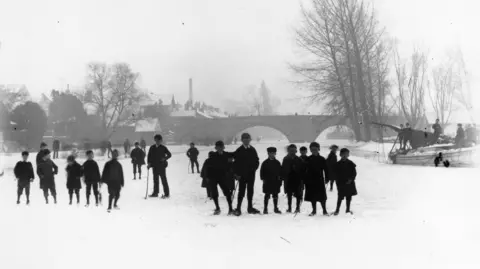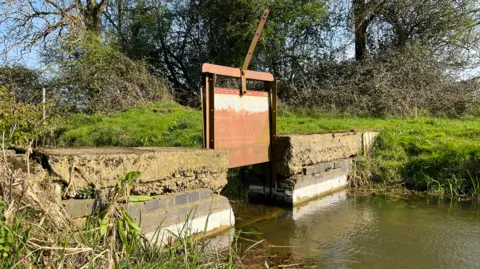A derelict device that could alleviate flooding
 St Neots Cambridge Community Archive Network
St Neots Cambridge Community Archive NetworkIt was once used to create an area for ice skaters, but now a Victorian sluice gate could be brought back into use to keep roads open during flooding. The BBC takes a look at the antique mechanism's potential revival and the land's use in a bygone age.
A Victorian sluice gate that has not been used for about 50 years has been suggested as a means of keeping roads open when they become deluged with flooding.
Mill Lane in Little Paxton, near St Neots, Cambridgeshire, was closed on four occasions last year during heavy rain and a £15,000 repair was carried out on the road in October.
A report published in March identified small scale works to ease water from the road, one of which was the revival of a Victorian sluice gate on Mill Lane.
The sliding door created a diversion route for some of the River Great Ouseduring winter, to allow the Lamas Meadow to fill with river water for ice skating.
The St Neots Flood Liaison Action Group said the sluice had "unfortunately been long forgotten", and was derelict, having not operated since the 1970s.
Its lack of use has meant a large quantity of flood water diverts across the common - where in recent memory, skaters had their fun - and towards Mill Lane.
 Harriet Heywood/BBC
Harriet Heywood/BBCIn the 1880s, a local skating association requested a way to freeze the fields on Lammas Meadow, as there were fewer winters harsh enough to create a safe skating environment on the river.
Alterations were made to the local drainage network, including the sluice, to create a counter-drain which took water from the Great Ouse on to the fields.
When the water on the meadow froze, it provided a safer place to skate than the river, where, in early Victorian times, several hundred people were on the ice. Races could bring in more than 1,000 spectators.
 St Neots Cambridge Community Archive Network
St Neots Cambridge Community Archive NetworkLiz Davis, a former curator at St Neots Museum, said she could remember some of the "incredibly hard, cold winters" of the 1960s and 70s, when the meadow was flooded for skating races and ice hockey.
"I don't know that the river has ever fully frozen over since the 1960s.
"I mean I can't even imagine it freezing over now... [it was] when Britain and Europe was much colder than now."
Local historian David Busby said the last reference to mass skating on the river itself was during the big freeze of 1929, when the ice was so thick a motorcycle and trailer were driven along the river.
He added there was always the "danger for the foolhardy" who would take a chance when the ice was not strong enough.
A 1856 press cutting described one narrow escape.
Someone named Mr Langley was skating on the river when the ice broke and he immediately sank.
The small sluice gate was believed to have been manually operated by a local landowner until the 1970s.
It is understood measures are being undertaken by Cambridgeshire County Council to improve recovery times at Mill Lane.
Follow Cambridgeshire news on BBC Sounds, Facebook, Instagram and X.
